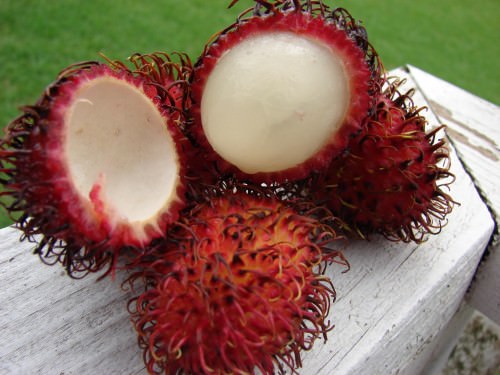The stalls of food markets in Southeast Asia are simply bursting with an abundance of outlandish fruits for us, especially in Thailand. In this country, tourists’ eyes run up from the fruit variety, and many of them opt for one very unusual fruit, similar to a small red nut and covered with long fleshy hairs. This is rambutan – one of the most popular fruits in this country.

- According to local legend, rambutan in Thailand appeared quite a by accident. It was brought by a Chinese or Malaysian tin miner who moved from Penang to Thailand and settled in the town of Surat Thani. He brought with him 5 seedlings of this fruit tree. A few years later, he was forced to return, and the rambutan planted in the garden began to grow and bear unusual and surprisingly tasty fruits.
- Years later, this land was acquired by the Ministry of Education and built a school there. A separate school garden was created for the overgrown rambutan trees. As a result, this fruit was called ngo rongrian, which translates as “school rambutan”. This name was firmly fixed for them and is still used today. Its Indonesian name rambut is translated as “hair”. I think it’s clear why.
- Rambutan outwardly resembles a small nut 3 to 6 cm in diameter, covered with red or yellow skin and decorated with long fleshy green hairs. These fruits grow in clusters of up to 30 pieces.
- The rambutan fruit tree itself is a tall evergreen tree with wide, spreading foliage. The leaves are oval or ovoid. During the flowering period, the crown of the tree is covered with small flowers collected in branched inflorescences.
- The harvest period lasts from May to September.
- In rambutan, they eat a translucent, juicy pulp of milky white color, very rich in vitamin C, minerals (phosphorus, iron, calcium), as well as carbohydrates, protein, and niacin.
- There are 2 types of rambutan: Rongrian (round, with bright red skin, greenish hairs, and sweet flesh) and Si Chom Phu (egg-shaped, with pink skin and pink tendrils, not as sweet as Rongrian).
- The fruit’s hair is a great shelter for ants, so shake the fruit thoroughly before peeling it.
- Rambutan is eaten in any form. It is eaten like this, peeled from the skin, and various jams and preserves are made from it. The pulp of the fruit is also used as a filling for pies, as an ingredient in salads, etc.
- It is important to present this fruit correctly. There is a cleaning method for this. First, you need to make a small circular incision around the fruit, and then carefully remove the thin skin from one part by pulling on the hairs. It comes off easily. Leave the second part untouched and use it as a convenient holder for the rest of the fruit. The pulp is eaten carefully, trying not to touch the bones, which can spoil the whole taste. On the table, the fruits themselves and dishes from them are served chilled.
- Rambutans spoil rather quickly, so it is recommended to use them immediately. The maximum shelf life in the refrigerator is 7 days.
- Thailand’s annual income from the sale of these fruits is about $ 12 million. This fruit even has its own holiday – School Rambutan Day, which is celebrated in August.
